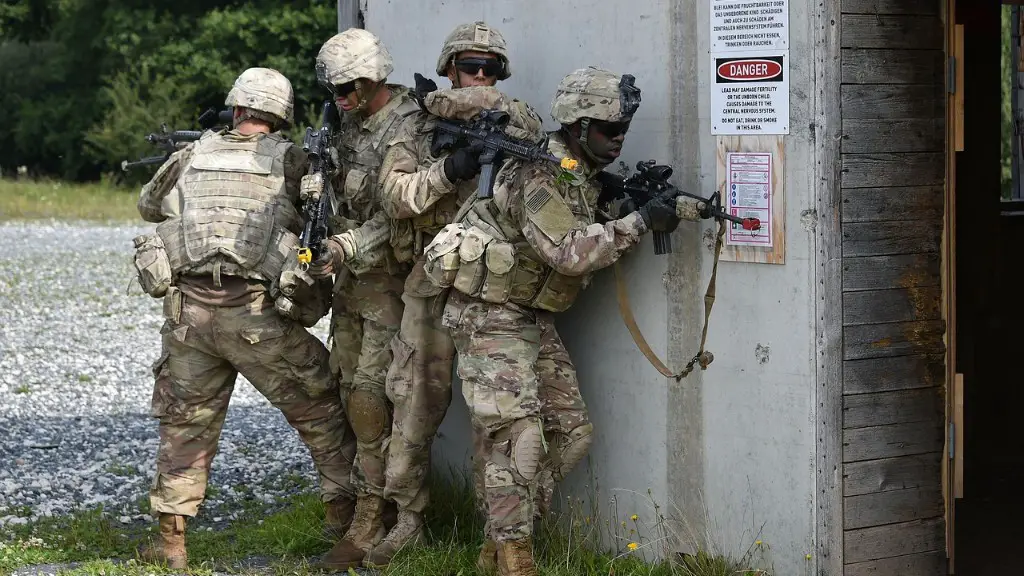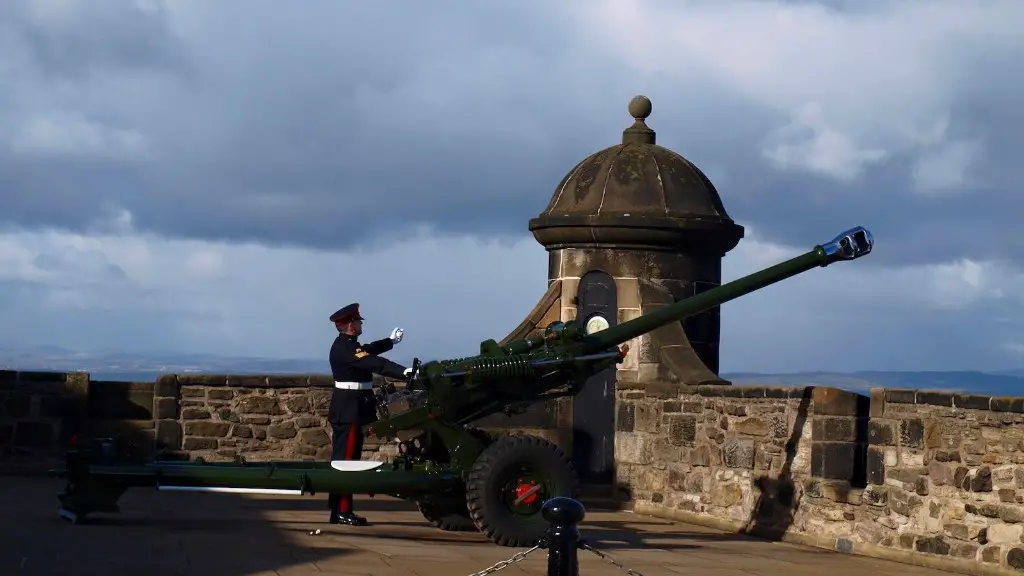The Chinese Army has a long and illustrious history as one of the world’s oldest military forces. From the times of the warring states, the Chinese military has always been an important component of China’s defence system. Today, the Chinese Army comprises of the People’s Liberation Army (PLA) and the People’s Armed Police (PAP). It is considered the world’s largest standing military with an active duty personnel force of 2.3 million and reserves of 1.1 million. The PLA has the mission of defending national sovereignty, security, and development interests. The PAP is mainly responsible for maintaining internal security and public order.
On the military technology front, the Chinese Army has always been at the forefront. It has advanced technology like precision guided munitions, advanced avionics, and more. Together with a massive budget of mobilization, the Chinese Army is now seen as a major rival to Western forces. In terms of power projection, the Chinese Army has positioned itself to intervene in regional disputes, peacekeeping operations, and even support combatant operations overseas.
In addition, the Chinese military has embraced new methods of warfare that focus on information, mobility, and surprise. It has adopted advanced cyber and observation technologies to better control the battlefield and disrupt communications. Its air and naval forces have developed advanced long-range missiles, stealth fighters and submarines, as well as modernised aircraft carriers and battle fleets.
When it comes to defense spending, the Chinese Army is well-funded. The China defense budget, which is approximately $228 billion, is the second highest in the world behind the United States. The Chinese government has prioritized military research projects, devoting significant resources to develop advanced weaponry, cyberwarfare and artificial intelligence-based weapons systems
When it comes to international relations, the Chinese Army has adopted more moderate approaches to foreign policy challenges. The Chinese government is more open to diplomacy than in the past and has sought to be more flexible in regional disputes. Beijing is also looking for more regional involvement to obtain better terms in its dealings with other countries. As a result, the Chinese Army is now seen as a partner in maintaining regional stability and peace in many areas.
In conclusion, the Chinese Army, as one of the world’s oldest military forces, is a formidable force. Over the years, it has adapted to the changing technological and geopolitical environment. With its massive budget, advanced technologies and modern approaches to foreign policy, the Chinese Army is now seen as a major rival to Western forces.
Deployment Servicemen
A key component of the Chinese Army is its deployment servicemen. As of 2019, the number of active servicemen deployed for operation in the region reached about 2.6 million and is expected to rise as Chinese forces expand their presence in other countries. Moreover, Chinese military personnel are now more heavily represented in international forces such as United Nations peacekeeping missions. This includes providing medical, engineering, and logistical support to international missions. By 2020, Chinese troops have participated in more than 20 United Nations peacekeeping missions. This demonstrates China’s commitment toward global stability and its willingness to cooperate with other countries in stabilizing volatile regions.
In addition, China has increased its investment in developing military personnel, investing in specialized training and education programs. For example, the Chinese Army has established several military academies, such as the National Defense University, to strengthen its officers’ educational background. Furthermore, the Chinese Army runs universities and research centers in partnership with private and international universities to enhance their scientific and technological knowledge.
Finally, the Chinese Army has invested in developing improved weapons systems. Examples of Chinese achievements include the development of precision-guided munitions and advanced avionics, as well as in radar and communication systems. These weapons systems have increased the effectiveness and lethality of the Chinese military.
Recruitment and Retention Strategy
The Chinese Army has a recruitment and retention strategy that emphasizes better training for its personnel, higher promotional gains for those who serve longer, and greater financial support for their families. The military offers educational opportunities including free tuition and housing, which are attractive to potential recruits. Additionally, generous benefits that include salary raises and housing allowances are also given to attract and retain high-level enlisted personnel.
In addition, the military has also made significant efforts to expand its recruiting base by reaching out to towns and cities where recruitment has traditionally been low. Recruitment centers have also been established in universities to tap into the country’s educated youth. This strategy has succeeded in attracting more qualified applicants, which has contributed to the increasing number of personnel joining the Chinese Army.
Moreover, the Chinese Army has also invested in technology to track and monitor soldier performance, operations, and training methods. This data-driven approach has allowed the Chinese military to assess the performance of its soldiers more accurately and develop more effective personnel management strategies.
Finally, the Chinese military has developed its own online platform, which allows personnel to access their training and operational records as well as to communicate with their units and make requests for additional resources. This digital platform has improved connectivity among the personnel, allowing for better coordination and communication of tasks. In this way, the Chinese Army is able to better utilize its personnel’s skills and talents.
Weapons and Technology
The Chinese Army is equipped with a wide range of advanced weapons and technology. Along with precision-guided munitions and advanced avionics, the Chinese Army has also developed an array of radar and communication systems. Additionally, the Chinese military is now investing in new weapon systems such as laser-guided bombs and hybrid drones. Furthermore, China’s research into artificial intelligence has played a key role in making its weapons system more reliable and effective.
Moreover, the Chinese Army has developed its own air defense missile system, which allows them to effectively intercept incoming missiles. Additionally, their army has also adopted advanced cyber warfare technologies, allowing them to disrupt and disrupt communication networks, track and identify targets, and perform electronic warfare.
In terms of surveillance technologies, the Chinese Army has adopted advanced satellite, radar and imaging technologies. These enable the Chinese military to monitor their surroundings and control the battlefield. Furthermore, the Chinese military is constantly investing in upgrading its surveillance capabilities to detect and counter potential threats more quickly and effectively.
Finally, the Chinese Army is investing heavily in the development of unmanned and robotic technologies. These systems can be used for a variety of military purposes, including reconnaissance, surveillance and combat. The Chinese military has already developed several advanced unmanned systems and is expected to continue investing in these technologies in the future.
Global Reach and Leadership
In recent years, the Chinese Army has sought to expand its global reach and influence. For example, China has increased its military presence in important strategic areas such as the South China Sea and the East and South China Seas. Additionally, China has taken part in international missions, including United Nations peacekeeping operations, which demonstrates its commitment to global stability. Furthermore, the Chinese military has also increased its participation in international activity, with growing involvement in multilateral organizations such as the Shanghai Cooperation Organization and the Conference on Interaction and Confidence-building Measures in Asia.
Moreover, the Chinese Army has also developed effective leadership and training programs. This includes officers who have advanced degrees in military strategy and international relations. Additionally, the Chinese Army has invested in the development of leaders with strong diplomatic skills and abilities to develop strong relationships with other countries. This has enabled the Chinese military to extend its influence and reach even further.
Furthermore, the Chinese Army has also adopted a more open strategy when dealing with foreign policy. Chinese leaders have engaged in dialogue with other countries and shown willingness to cooperate in regional disputes. This demonstrates China’s commitment to regional stability and peace. China has also bolstered its international image by playing a more active role in international organizations, engaging more closely with neighboring countries, and engaging in humanitarian activities.
Finally, China has also improved its military strategy and tactics. This includes adopting advanced weapons systems, developing new tactics for combat, and improving their technical capabilities. As a result, the Chinese Army has been able to rise rapidly to the level of a major military power.




